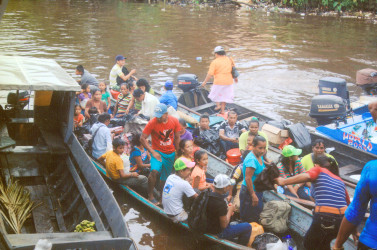Thousands of miles may separate the metropolitan capitals where gold prices are set from the remote Amerindian communities in the interior of Guyana like Sebai, but the impact of decision-making in the metropolis on communities like Sebai could hardly be starker.
Sebai is located on the right bank of the Sebai river, twenty five miles away from Port Kaituma. The village hosts a community of around 420 Caribs, Arawaks and Warraus. Traditionally, the community’s main economic activities have been logging and farming, in the case of the latter, mostly cassava and cash crops. Gold mining has been a relatively recent addition to Sebai’s economy and it has not been all to the good of the community.

Two weekends ago a few speed boat loads of villagers from Sebai had made the two-hour trip to Port Kaituma to sell their cassava, cassava bread and cash crops on the waterfront there. This is a serious undertaking It occurs on Wednesdays, Thursdays and Saturdays and begins at around 8:00 hrs. The sellers from Sebai arrive in their customary unfussy way and begin to sell.
Much has changed over the past year or two. Time was when they could depend on the patronage of the miners who would buy their goods and take them to their mining camps. The price of gold has ‘gone south,’ the miners are trekking back from the goldfields and the Sebai vendors must find other markets for their goods.
These days they depend on the patronage of the residents of Port Kaituma who are themselves financially ‘hard up’ on account of the fact that many of the men in the community are the same miners who have have returned from the goldfields. They too are victims of falling gold prices and strapped for cash.
On the waterfront something has to give. Each vendor must find at least the $2,000 return fare (goods inclusive) to Sebai – so they plead with the regular vendors on the Port Kaituma Wharf to take what is left off them. Nothing goes back to Sebai. What eventually remains is entrusted to the Port Kaituma vendors to dispose of and the takings are held onto until the villagers from Sebai come to the waterfront again.
In more ways than one it has been a devastating transformation of fortunes for the community of Sebai. Their own menfolk have also been dealt an ugly hand by the change in the fortunes of gold and the knock-on effects of falling gold prices in an interdependent economy have come around to ‘bite’ them – a second time.
The Sebai vendors are reflective rather than dejected. They are preoccupied with the consequences of another disastrous trading day. We felt lucky that we were able to distract one of their number from her thoughts.
Sylvia Hutson told us than when gold was “running,” she would arrive at Port Kaituma with six or seven ‘hampers’ of cassava bread, among other things. They would sell quickly and she would ‘pocket’ $15,000 – $20,000 for her efforts. These days she feels fortunate to return to Sebai with $3,000.
There are other ways in which the communities in this region are interdependent. After the vendors from Sebai had finished their trading day they used to plough back much of their earnings into the Port Kaituma economy, purchasing food and clothing to take home with them. These days they have far less to spend so that the shopkeepers of Port Kaituma are ‘feeling the squeeze’ as well. These women have learnt to ‘feel the edges’ of what little money they earn. Calculating the cost of living here involves the coldness of factoring in what it costs to move consumer goods from Georgetown to Port Kaituma.
Sylvia was telling us that this year she was late in the acquisition of school supplies for her three children. She said she was worried. Not far away, Carol, a coastlander who now sells fruit and vegetables at Port Kaituma was trying to ‘do a deal’ with another of the Sebai women whose trading day had gone less well than she had hoped.
The women of Sebai are worried too that as the gold option recedes further an increasing number of younger women are finding their way to Pork Kaituma looking for jobs, mostly as shop assistants. But few people are hiring and young, single women in search of jobs are vulnerable in a community like Port Kaituma.





